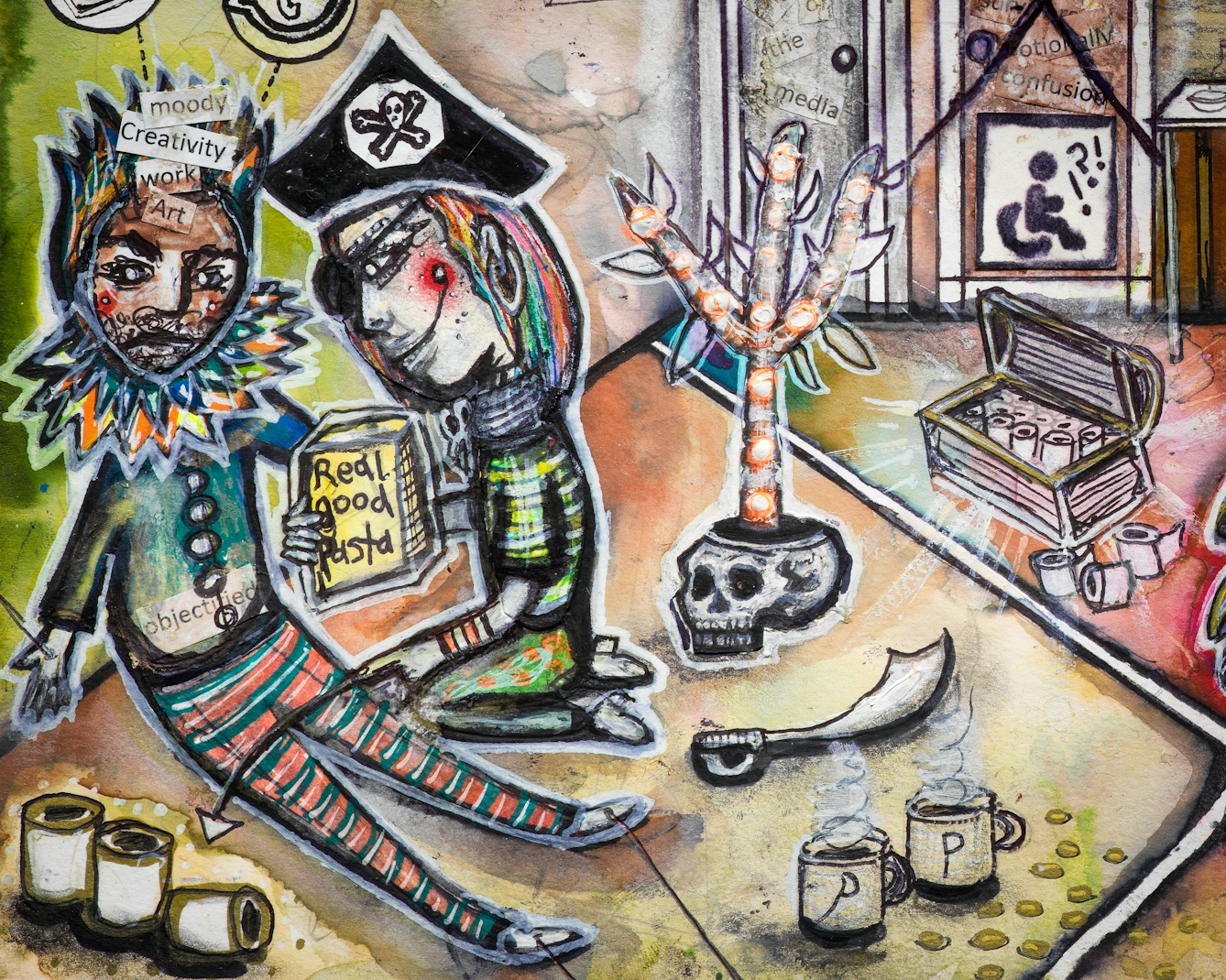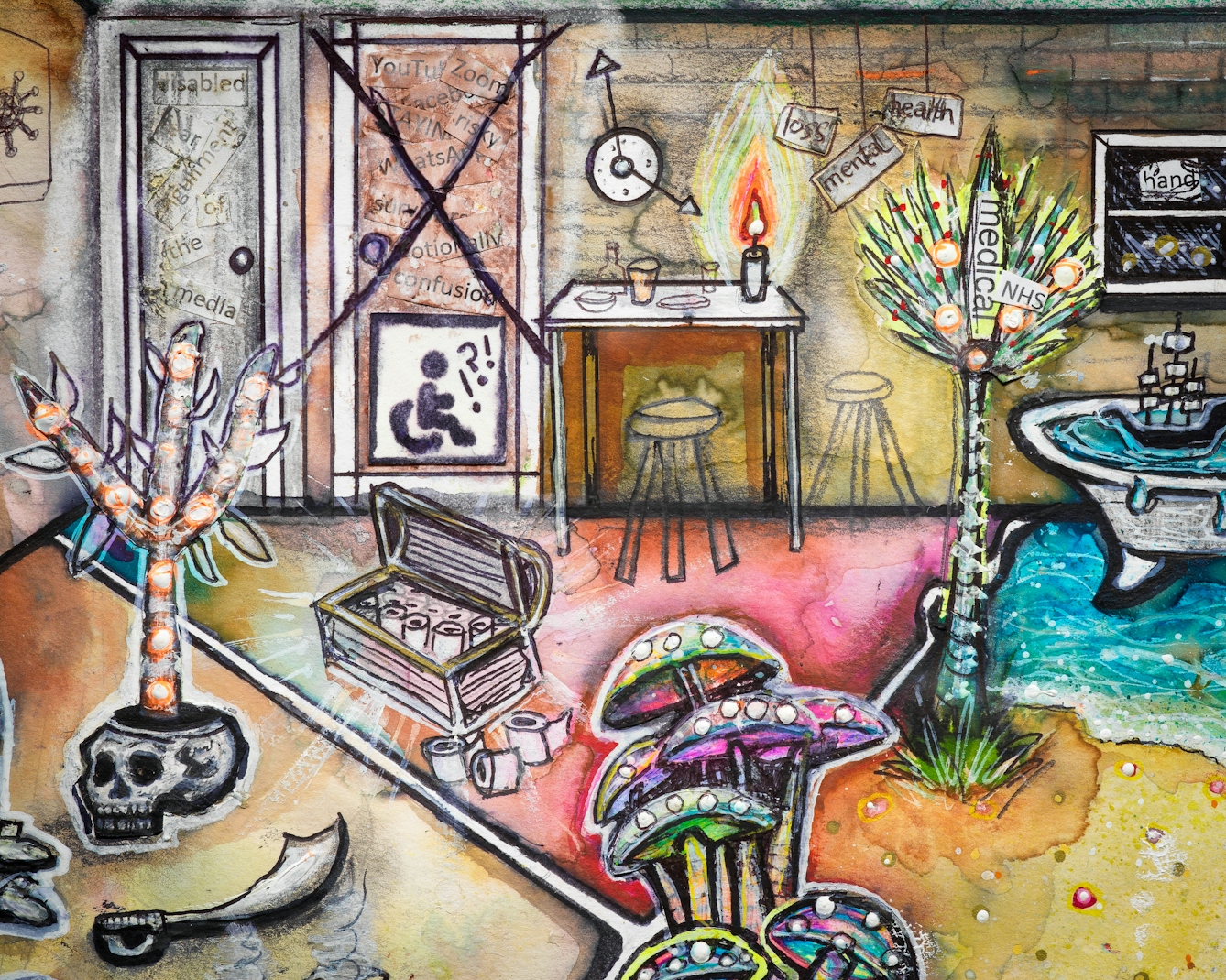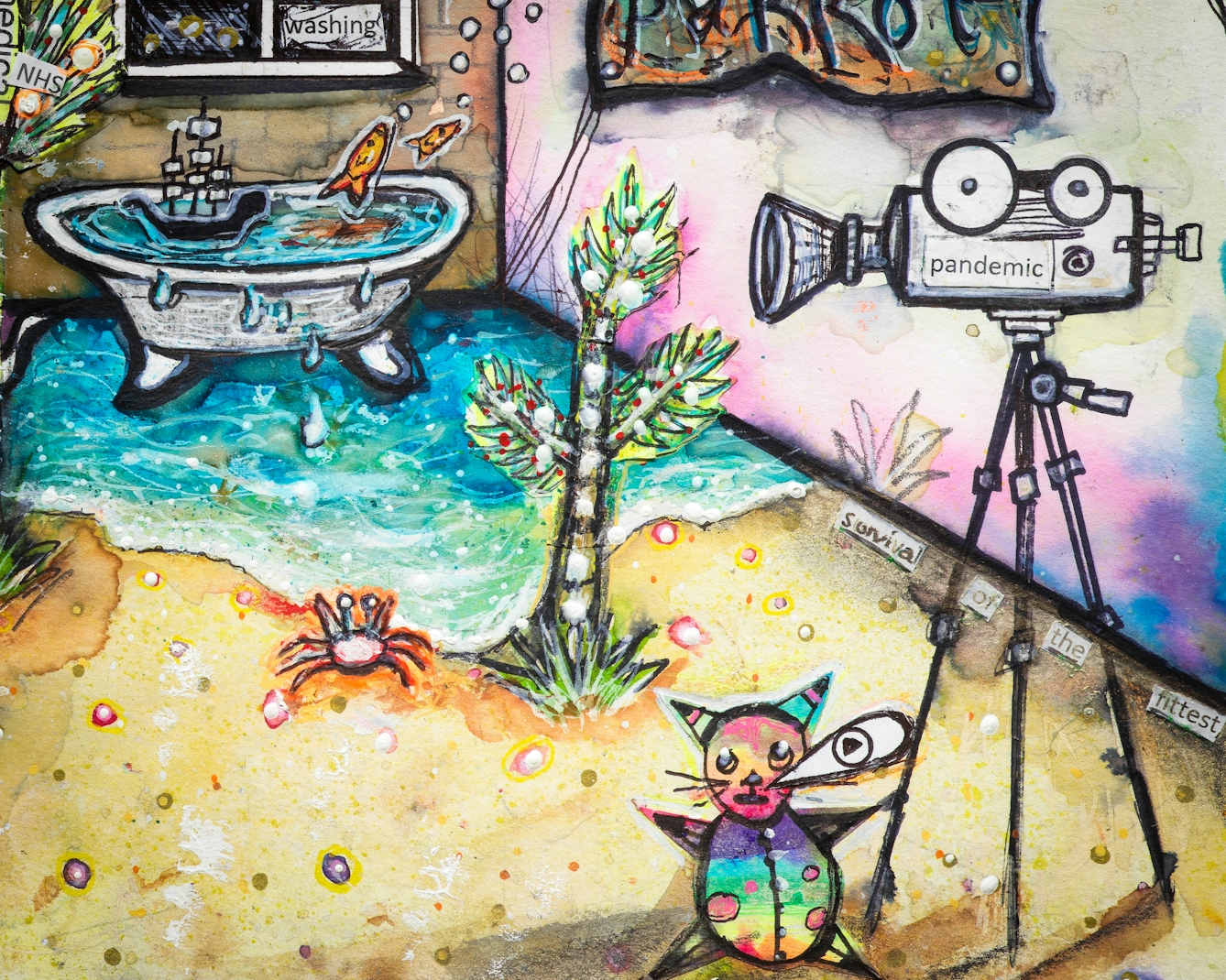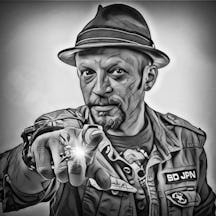Actor and comedian Gareth Berliner found that being Disabled gave him and his wife the resilience to cope with the stresses of a global pandemic. Despite being at high risk, they were able to embrace lockdown and even found a new outlet for their creative talents.
How to thrive in lockdown
Words by Gareth Berlinerartwork by Carrie Ravenscroftaverage reading time 7 minutes
- Article

We knew shielding was coming a few days before it was officially announced. My wife, Kiruna, and I were in the park when lockdown started to look like a reality. We had heard it being discussed on TV and in snatches of conversations as people walked past. As we left the park, I said, “When we get home, we’re not going out again.”
We were lockdown-ready
The vulnerable always duck for cover first. We’re trained; we’re survivors. Clinically vulnerable? Yes. Adaptive and resilient? More than most. It’s a strength we have that others don’t.
Now, I’d like to say the above paragraph was entirely true, and to a degree, it is. But we still had to deal with the trauma of change, fear and confusion that everyone else was about to go through.
My wife and I both identify as Disabled under the social model. Kiruna has dwarfism. She’s an actress and a very confident person but, as a woman of short stature, when she’s out in public, she experiences ‘othering’ on a daily basis. She is objectified: a sly glance, a giggle, a nudge to a friend, a finger pointing at the little lady as she goes past. So she doesn’t have a problem hiding away from the world if needs be.
As for me, well, I’ve spent years in hospital – from short two-week stays to long stretches of up to six months – so I’ve experienced real isolation.

“The vulnerable always duck for cover first. We’re trained; we’re survivors. Clinically vulnerable? Yes. Adaptive and resilient? More than most. It’s a strength we have that others don’t.”
Following the herd (immunity)
So, we went home and… started shielding. They managed to make it sound really dramatic, didn’t they? I guess ‘shielding’ sounds better than ‘staying in’! We began to consume information voraciously. The message coming through was frightening: about two weeks before lockdown, Boris Johnson had suggested that we would lose the elderly, the Disabled, the vulnerable.
A couple of days into shielding, Johnson had stopped mentioning the Disabled and vulnerable. If he wanted the public to go along with the idea of herd immunity and survival of the fittest, it was wise to understate the risk to the vulnerable and Disabled.
Then they changed their tune. Why? Because fit people, both young and middle-aged, began to die. Suddenly, when the nation realised we were all at risk, most of us began to take it seriously. During this period selfish behaviour was rife. While we couldn’t go out to the shops, others could, and they cleaned out the shelves.
Shielding to stay alive
Kiruna and I were on the council’s vulnerable list and soon began to receive weekly care packages. Always really good pasta, for some reason, and at least one toilet roll. Who knew that in a global pandemic, toilet rolls would be such precious cargo? It was harder for us to get on to the clinically vulnerable and isolated list for supermarket deliveries. All of our online accounts were in Kiruna’s name, whereas I was the one who’d received the “You need to shield!” letter.
In fact, before we even received the letter from the GP and the government, we received a phone call from my hospital doctor. My impairment means I’ll be in and out of hospitals for the rest of my life, on average once or twice a year. My specialist didn’t pull her punches.
“Gareth, don’t, under any circumstances, come to the hospital. Look after your Hickman line [a small, soft tube in the chest used for long-term access to veins to give nutrition, etc.]. Practise even better hygiene than normal. If you end up in here for a line infection, you’ll catch Covid and die.”

“Gareth, don’t, under any circumstances, come to the hospital. Practise even better hygiene than normal. If you end up in here ... you’ll catch Covid and die.”
When hospitals are a danger
With ventilators in short supply, I think she was concerned about my chances. Faced with the choice of putting me on a ventilator – a 48-year-old married man with no children, Crohn’s disease, short gut syndrome, an immunodeficiency condition, and early-onset osteoporosis – or a married man with kids and no comorbidities, they would definitely choose the other guy.
If I get an infection in the Hickman line, I’m at risk of sepsis, which is no joke. Normally, if I feel unwell, I pop up to the hospital so that they can take cultures from my line. But the pandemic made this routine procedure much, much harder. When I eventually did have to go to the hospital for a check-up, the team worked quickly to minimise my time there. As I type this, I’ve had to press pause on shielding to go back into hospital, and it’s still very risky for me to be here.
How many national emergencies can you handle?
Months before the pandemic hit, the Medical Health and Regulations Authority (MHRA) had announced a national emergency regarding the life-saving nutritional fluid that is fed through the line in my chest.
There was a severe risk that this fluid had been micro-contaminated, and this led the private company that makes the fluid to slow production right down. As a result, I was on a very basic fluid, which was not as good for me; it was like going from a diet of sirloin steak to spam.
I’d been fighting the government-run MHRA’s decision to slow production since July 2019. They may be a regulatory body, but when the company causing the contamination risk has a monopoly on supplying the NHS, the MHRA won’t pull that company’s licence for fear of overburdening the NHS with a huge influx of patients. Now, with Covid-19 too, I was fighting two national emergencies.
Rescuing our mental health
Emotionally, I began to find things much harder when we hit week nine of lockdown. Two national emergencies were finally taking their toll on my mental state. I was moody and irritable, venting at my wife, and I knew I had to get a grip. I was also dealing with the loss of my working life.
I am a stand-up comedian and actor. Both these industries had been decimated overnight. And I was under doctor’s orders not to do the work that had survived. So, on top of everything else, I was having to think about how I would find an alternative income in the future.

“I remembered an old kids’ show, ‘Pirate and Parrot’, that Kiruna and I had created back in 2014. We worked for more than two months on the show, creating and filming it in our lounge.”
To rescue my mental health, I needed to find a distraction for Kiruna and me that would pass the time productively, harness our talents, and give us a sense of direction and purpose at a time when we felt lost and isolated, and ignored by the world outside our window.
I remembered an old kids’ show, ‘Pirate and Parrot’, that Kiruna and I had created with Red Earth Theatre back in 2014. I contacted Red Earth and we worked for more than two months on the show, creating and filming it in our lounge. We’ve already received our first commission to produce a series of podcasts. Creativity and art really do have the power to heal.
Survival skills of the Disabled
When the government finally called an end to shielding, I didn’t feel we were any safer. Government ministers just seemed to be shrugging off their responsibilities and trying, wherever possible, to blame the people. They blamed us for breaking lockdown rules, but it was okay for the prime minister’s adviser to break them.
And don’t for a minute think about blaming the government ministers who took it on themselves to tell us what to do. They ducked out of COBRA meetings, they hummed and hawed, they dabbled in herd-immunity theory before taking coronavirus seriously, causing nearly 70,000 UK-registered deaths from Covid-19, according to the latest government figures in December 2020.
At the beginning of this piece I spoke about the survival skills of the Disabled. Kiruna and I faced and embraced lockdown. We forged ahead creatively and, while stuck inside, found resolve, produced work and started A Little Commitment, our own production company. During our second lockdown, I can only hope there are more great ideas and creations to come from our imaginations. We’re applying for funding to turn ‘Pirate and Parrot’ into a children’s TV show. And, with A Little Commitment, I think we’re going to do it!
About the contributors
Gareth Berliner
Gareth Berliner is a Disabled comedian, actor and writer. He says if you’d like to know more, you can find out on his website and with A Little Commitment.
Carrie Ravenscroft
Carrie is a queer and neurodivergent artist from London. Her art practice focuses on women’s health, late diagnosis and the mind-body connection, which she communicates through colour, characters, and symbolism in detailed, linked artworks. Recent creative projects include a neuroart exhibition in collaboration with neuroscientists at the Kings College ADHD Research Lab. Outside of making art, Carrie is a a mental health support worker and art psychotherapist at Mind, the mental health charity, and volunteers as a psychedelic first aider with the charity PsyCare.

